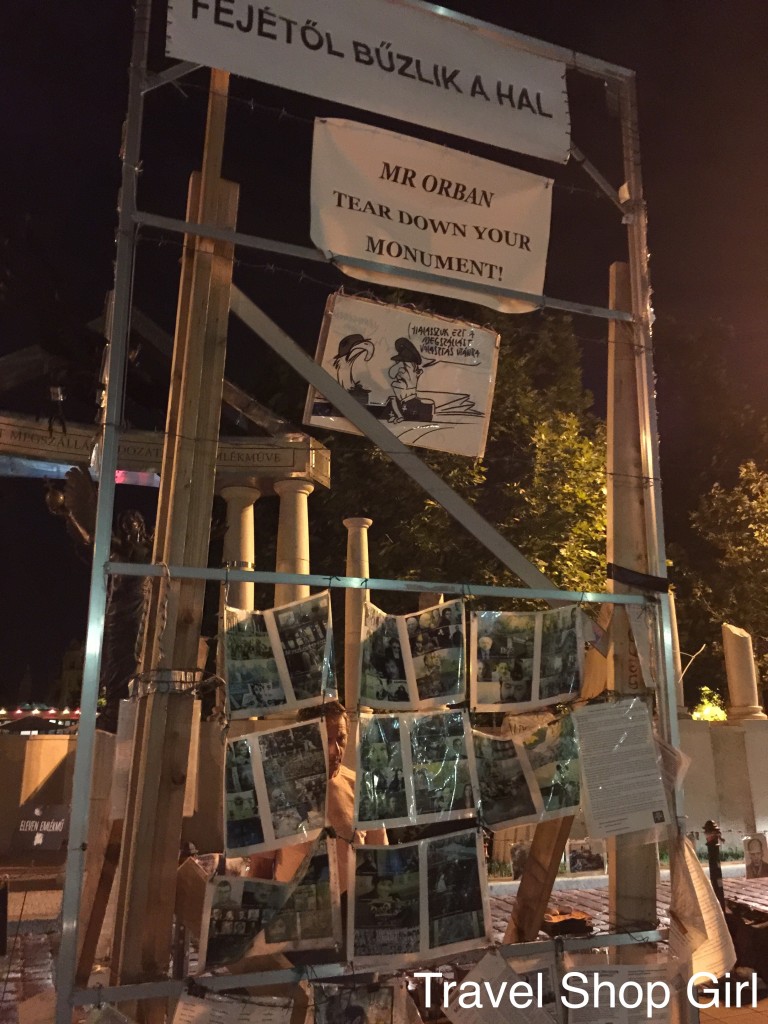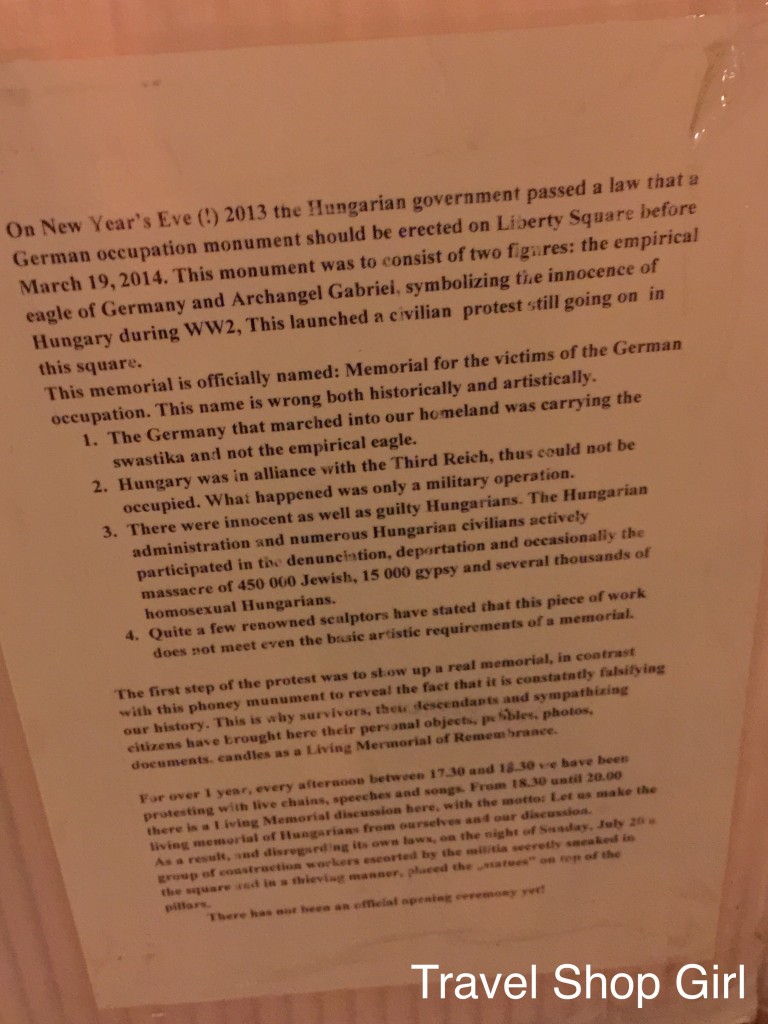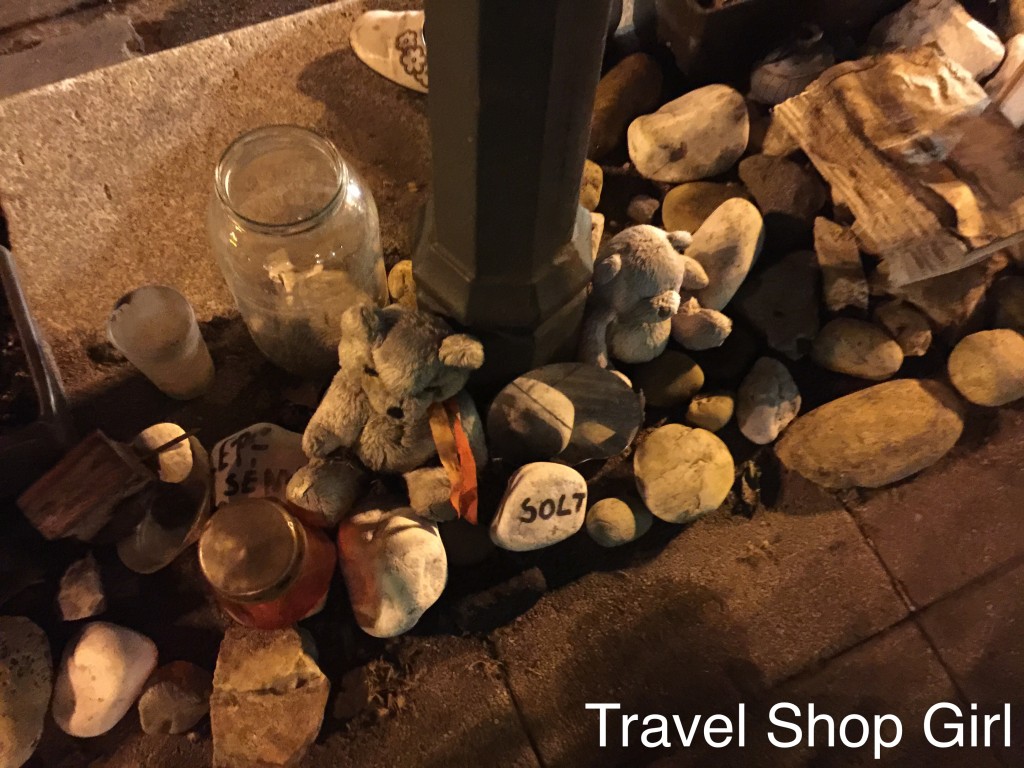
When memorials are erected for individuals, they’re done so as a tribute for those who have passed and as a way to always remember them. Memorials for specific events are built not to memorialize a tragedy, but to remember those lives lost while at the same time using it to teach future generations, thereby ensuring that history doesn’t repeat itself. An example of this type of memorial is the 9/11 Memorial in NYC. Most memorials are conceived, constructed, and supported by the communities in which they will reside and for the most part, all of this is done without debate. That is, but for the German Occupation Memorial in Budapest, Hungary, which was erected under the cover of darkness in 2014 and was from the beginning, a major controversy. Why is it then that Hungarians don’t want this memorial in Budapest?
On a warm night in Budapest recently as I walked with my friend Karla through Szabadság tér (Freedom Square) after riding the Budapest Eye, we stumbled upon the German Occupation Memorial. Being an avid photographer who never wants to miss an opportunity to take yet another picture, I took a picture of what appeared to be simply an angel surrounded by columns. What I didn’t know was that this memorial was put up against the wishes of the Hungarian people in the middle of the night on 20 July 2014. Why were people upset about this memorial and why was it erected against everyone’s wishes?

The memorial: Let’s start at the beginning or at least the beginning of the creation of the memorial, which was built by Hungarian sculptor, Peter Parkanyi Raab. At the middle of the monument is archangel Gabriel (representing an “innocent Hungary”) who stands on a column with an orb in his right hand (representing the power of the state). A bronze eagle with a ring on its leg reads, “1944,” soars above Gabriel as a representation of Nazi Germany. Above the columns it reads, “A német megszállás áldozatainak emlékműve: Memorial to the Victims of the German Invasion.” But what is it about this memorial that causes such controversy?

It’s easy to see now that Orbán’s reply to MAZSIHISZ was a carefully crafted political work of fiction in which he suggests that they could continue discussions after the Easter holiday in April. Many took this to mean that the government’s intent was to postpone the installation of the memorial. However, when workers appeared on 8 April and began closing off part of the square, you can understand why Hungarians were completely outraged. Orbán and the Fidesz party won the elections and as politicians often do, he simply went back on any promises he made and moved forward with his plans for the memorial.

The protests: While a few, including sculptor Raab, believe the monument is intended to serve as a reconciliation between Jewish and non-Jewish Hungarians, the majority of Hungarians simply don’t agree. Protests continue in Szabadság tér in what the Hungarians believe is the “forgery of the history” of Hungary. They feel that by basically eliminating the nation’s culpability in the Holocaust, Hungary is portraying itself as a victim and not a contributor and co-conspirator in the atrocities. Hungarians feel that this recreation of history is placing the responsibility for the deportation, disappearance, and death of more than 500,000 Hungarian Jews in World War II solely on Nazi Germany and not equally between the two countries. The German Occupation Memorial still stands today in Freedom Square and is reported to be the most protected object in Hungary.
The word that incites a nation: “Victim”: I suspect that the word “victim” is what bothers Hungarians the most. While there are obvious victims as a result of the Holocaust, to say “all of the victims” on the memorial somehow lumps the country of Hungary in with actual victims. Believe me, nothing makes people angrier than when someone tries to innocently and unfairly play the victim card.
Prime Minister Orbán was less than apologetic when responding to 30 US congressmen of Jewish ancestry who asked for the memorial’s cancellation months before it was erected and believed that…
..Hungary’s remaining Jewish population should participate in determining the appropriate way to remember the suffering of Hungary’s Jews during this period.
Prime Minister Orbán’s response?
The monument that you referred to, which we are erecting on the occasion of the 70th anniversary of Hungary’s German occupation, and the loss of state sovereignty, is not a Holocaust memorial. Moving Holocaust monuments and memorial sites already exist in Hungary.
The composition erected now is a freedom fighting people’s memorial of the pain of having its liberty crushed. This monument, paying tribute to the memory of the victims, reminds us all that the loss of our national sovereignty led to tragic consequences, claimed the lives of hundreds of thousands, and brought immense suffering upon further millions, the entire nation.
History cannot be recreated nor can it ever be rewritten. Historians, including Hungarian historians, agree that there is a shared responsibility between Germany and Hungary for the Holocaust in Hungary. If this is undeniable and indisputable, then the Prime Minister and the government should apologize and remove the memorial immediately. But I suspect that this is far easier said than done and we all know that politicians have a hard time apologizing for anything.
Here’s a short Vimeo clip of Eleven Emlekmű during the day.
As you can see in the video, the average person seems oblivious to the significance of the German Occupation Memorial.
The Eleven Memorial: But keep in mind that I knew nothing about any of this while I was walking around that night. I first noticed volunteers cleaning and maintaining the living memorial. It was only when I noticed the signs and various items and personal effects included in the Eleven Emlekmű (Eleven Memorial) that I felt compelled to not only learn the true story, but to share it. I admit that I’m not a history scholar and that I didn’t know anything about the role that Hungary played in the Holocaust, but ignorance can’t be an excuse. Sadly, while I walked around, I actually heard tour guides point out the memorial to tourists but mention nothing about the controversy or the living memorial. Whitewashed tourism at its best.
You’ll see that Eleven Emlekmű is very personal and includes haunting photographs, personal objects and mementos that include toys, shoes, placed stones, and letters with the names on them. I was immediately drawn in by the photographs and the personal objects and felt overwhelmingly sad, which took me completely by surprise. These were the people who had lost their lives, these were people who no longer had a voice. While at that time I didn’t understand the connection between the living memorial and the actual memorial, it doesn’t take much to see now that the German Occupation Memorial constructed by the government in the middle of the night doesn’t represent the people of Hungary at all.
The following is an excerpt from Cultures of History on the German Occupation Memorial which I believe best sums up what we as a society has to consider in order to grow, learn, and evolve.
This is part of ….”an opinion piece by István Jelenits, a very influential Piarist friar, who is regarded as sympathetic to the current government. Jelenits regards the monument as confusing in its message: “If the people who designed the statue really intended to say what you have so delicately and circumspectly said, then one can hardly create a statue that expresses this complex message.” According to Jelenits, “in order to shape the historical consciousness of a nation, we need not statues, but well-written history books.”
It isn’t enough to erect a memorial, especially if we then also decide to revise history in the process.
What can you do? Join the Eleven Memorial FaceBook group, read up on your history, don’t always accept things at face value (like when on a tour in another country), write a letter, and offer your support to the living memorial in person if you visit Budapest. But more importantly, don’t be scared to speak up and do the right thing when it counts. All it takes is one person to speak up and others to join in to make change possible.
Never doubt that a small group of thoughtful, committed citizens can change the world; indeed, it’s the only thing that ever has.
Margaret Mead
While this was an extraordinarily long post and outside of the norm of my typical travel post, my hope is that you’ll look beyond the obvious in your own travels and make each experience one from which you can learn something.


















2 thoughts on “Why Hungarians Don’t Want a German Occupation Memorial”
Comments are closed.